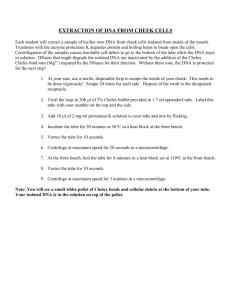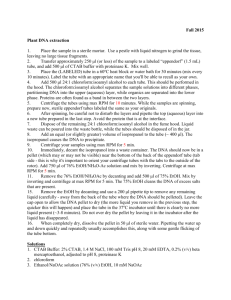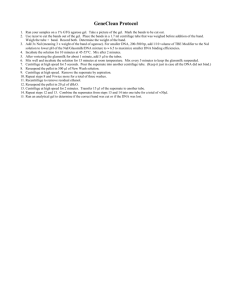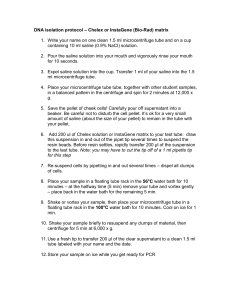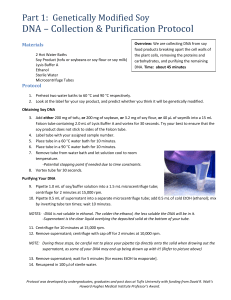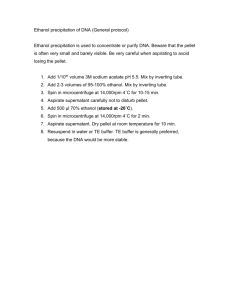Lab 2: DNA extraction - Cal State LA
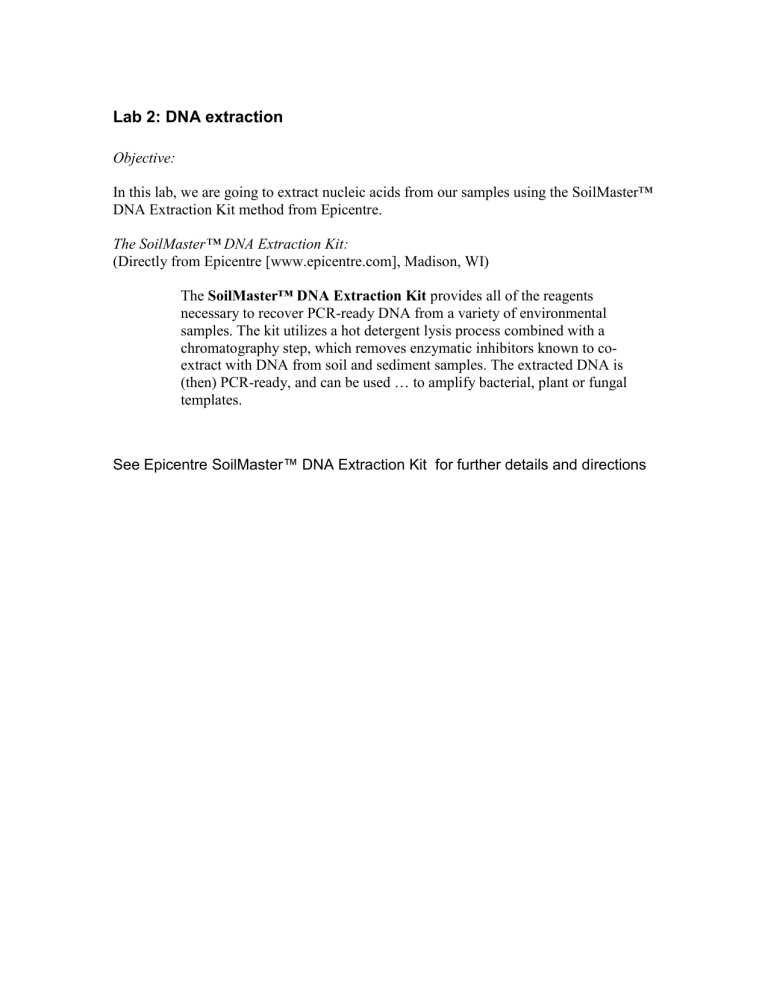
Lab 2: DNA extraction
Objective:
In this lab, we are going to extract nucleic acids from our samples using the SoilMaster™
DNA Extraction Kit method from Epicentre.
The SoilMaster™ DNA Extraction Kit:
(Directly from Epicentre [www.epicentre.com], Madison, WI)
The
SoilMaster™ DNA Extraction Kit provides all of the reagents necessary to recover PCR-ready DNA from a variety of environmental samples. The kit utilizes a hot detergent lysis process combined with a chromatography step, which removes enzymatic inhibitors known to coextract with DNA from soil and sediment samples. The extracted DNA is
(then) PCR-ready, and can be used … to amplify bacterial, plant or fungal templates.
See Epicentre SoilMaster™ DNA Extraction Kit for further details and directions
Pre-lab Exercise 2:
Carefully read through the Epicentre Biotechnologies SoilMasterTM DNA Extraction Kit document and Laboratory Exercise 2 and answer the following questions:
1.
The Epicentre kit relies on which of the following for the lysis process (2 points)? a.
Phenol-chloroform b.
Sonication c.
Hot detergent d.
Bead-beating
2.
Look up Proteinase K on the internet and describe the purpose this enzyme serves in extraction protocols (2 points).
3.
What negative result might vortexing have (2 points)?
4.
Which is the chromatography step of this protocol and what does it remove from your sample (2 points)?
5.
What is the final volume of the extracted DNA sample (2 points)?
Laboratory Exercise 2:
Supplies (per person unless otherwise stated):
Bunsen burner
Ethanol spray bottle
Paper towels
Kim wipes
Flint
65 o
C heat block for entire class
Waste container
Marker
Bucket of ice
Stopwatch (share, only some lockers have these)
Microcentrifuges
Pippettes, 0.5-10
l, 5-50
l, 20-200
l, 100-1000
l (1 set per 2 persons)
Pippette tips for all volumes
Microcentrifuge tubes 2 ml (1 box of 50 per person)
Microcentrifuge tubes 1.5 ml (1 box of 50 per person)
Drying rack for microcentrifuge tubes (2 for entire class)
Microcentrifuge rack
Vortex
Soil Sample on ice
Solutions (per person unless otherwise stated):
Epicentre prepared column (one per person)
TE buffer (2 ml yellow tube)
Epicentre SoilMaster™ DNA Extraction Kit with appropriate buffers
Vortex Demonstration, timer demonstraction.
Before you begin:
You will be sharing Bunsen burners to avoid overheating the lab. I will not guide you through each step of this lab. Now that you have some experience with sterile technique and pipetting, it’s time to put it to work.
Make certain to sanitize your work area, and wear gloves at all times. All the solutions and supplies you will need should be in your microcentrifuge rack. If you have any questions, please don’t hesitate to ask me during the lab… otherwise, as soon as you’re ready, begin!
After you complete a step in your protocol, please put a checkmark in the box next to the step number.
Good luck and REMEMBER: DO NOT leave anything exposed!
Epicentre SoilMaster™ DNA Extraction Protocol(* remember your aseptic techniques):
___ 1.
Pick up an inhibitor removal Epicentre Spin Column from the head of the class (provided) and set aside.
___ 2.
Observe your soil sample, take note of characteristics (color, size, heterogeneity of the material).
___ 3.
Add your collected soil sample to a 2mL microcentrifuge tube. Try filling about ¼ th
of the tube. To get the soil into the tube, you should use a dry pipette tip without the pipette (to scrape some soil from your bag into the tube).
___ 4.
Add 250
l of the provided Soil DNA Extraction Buffer (in a SMALL
CLEAR tube) and 2
l of Proteinase K (provided on ice at the head of the class, come see me with your tube when you are ready to add the
Proteinase K);
___ 5.
Vortex for 2 minutes.
___ 6.
Add 50
l of Soil Lysis Buffer (in a SMALL CLEAR tube) and vortex briefly.
___ 7.
Incubate at 65 o
C for 10 minutes.
___ 8.
Centrifuge for 2 minutes at 1000 x g.
___ 9.
Transfer 180
l of the supernatant to a new tube. Label the new tube with your initials and set aside the old tube.
___ 10.
Add 60
l of Protein Precipitation Reagent (in a SMALL CLEAR) mix thoroughly by inverting the tube.
___ 11.
Incubate on ice for 8 minutes. (share timers 4 people can use one timer)!
Centrifuge the tube for 8 minutes at maximum speed. Balance the tube with one of your classmates before running the centrifuge.
___ 12.
Carefully transfer 100-150
l of the supernatant directly onto your inhibitor removal Epicentre Spin Column.
___ 13.
Centrifuge for 2 minutes at 2000 x g into the 1.5 ml tube. Discard the column, retaining the flow-through and label the tube with your initials.
Take note of the color of the flow-through.
___ 14.
Add 6
l of DNA Precipitation Solution (provided at the head of the class), vortex briefly.
___ 15.
Incubate the tube at room temperature for 5 minutes.
___ 16.
Centrifuge for 5 minutes at maximum speed. Carefully decant the supernatant.
___ 17.
Wash the pellet with 500
l of Pellet Wash Solution (in LARGE
CLEAR) and invert the tube to mix.
___ 18.
Centrifuge for 3 minutes at maximum speed. Carefully decant the supernatant.
___ 19.
Wash the pellet again with 500
l of Pellet Wash Solution and invert to mix.
___ 20.
Centrifuge for 3 minutes at maximum speed. Carefully decant the supernatant.
___ 21.
Resuspend the pellet in 300
l TE Buffer.
___ 22.
Make certain your tube contains all the appropriate information on the top if possible and if not, on the side. Store your samples in the freezer.
Laboratory Report 2:
1.
Describe your soil sample (color, size of grins, heterogeneity of the material etc…). Do you feel the subsample you transferred into the microcentrifuge tube is representative of the overall sample (5 points)?
2.
What might you expect of your DNA extract if you forgot to add Proteinase K during the extraction (2 points)?
3.
What was the purpose of heating your sample to 65 degrees C (2 points)?
4.
What was the color of your sample after passing through the Inhibitor Removal
Spin column? What is suggested if color remains in the extract after this step? (6 points)
5.
When presenting data at a scientific conference, you must describe the methods you used to your audience. Summarize the procedure followed in this lab as if you were BRIEFLY describing your methods for a poster presentation. (Hint: there are 22 steps to this protocol, try to summarize the entire procedure in approx
5 bulleted points) (10 points).
